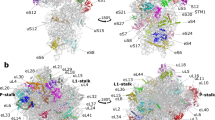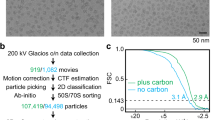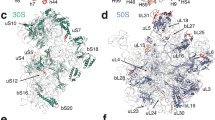Abstract
Protein synthesis by the ribosome is highly dependent on the ionic conditions in the cellular environment, but the roles of ribosome solvation have remained poorly understood. Moreover, the functions of modifications to ribosomal RNA and ribosomal proteins have also been unclear. Here we present the structure of the Escherichia coli 70S ribosome at 2.4-Å resolution. The structure reveals details of the ribosomal subunit interface that are conserved in all domains of life, and it suggests how solvation contributes to ribosome integrity and function as well as how the conformation of ribosomal protein uS12 aids in mRNA decoding. This structure helps to explain the phylogenetic conservation of key elements of the ribosome, including post-transcriptional and post-translational modifications, and should serve as a basis for future antibiotic development.
This is a preview of subscription content, access via your institution
Access options
Subscribe to this journal
Receive 12 print issues and online access
$189.00 per year
only $15.75 per issue
Buy this article
- Purchase on Springer Link
- Instant access to full article PDF
Prices may be subject to local taxes which are calculated during checkout




Similar content being viewed by others
References
Jelenc, P.C. & Kurland, C.G. Nucleoside triphosphate regeneration decreases the frequency of translation errors. Proc. Natl. Acad. Sci. USA 76, 3174–3178 (1979).
Kim, H.D., Puglisi, J.D. & Chu, S. Fluctuations of transfer RNAs between classical and hybrid states. Biophys. J. 93, 3575–3582 (2007).
Wohlgemuth, I., Pohl, C. & Rodnina, M.V. Optimization of speed and accuracy of decoding in translation. EMBO J. 29, 3701–3709 (2010).
Feldman, M.B., Terry, D.S., Altman, R.B. & Blanchard, S.C. Aminoglycoside activity observed on single pre-translocation ribosome complexes. Nat. Chem. Biol. 6, 244 (2010).
Munro, J.B., Wasserman, M.R., Altman, R.B., Wang, L. & Blanchard, S.C. Correlated conformational events in EF-G and the ribosome regulate translocation. Nat. Struct. Mol. Biol. 17, 1470–1477 (2010).
Alden, C.J. & Kim, S.H. Solvent-accessible surfaces of nucleic acids. J. Mol. Biol. 132, 411–434 (1979).
Rozenski, J., Crain, P.F. & McCloskey, J.A. The RNA Modification Database: 1999 update. Nucleic Acids Res. 27, 196–197 (1999).
Chow, C.S., Lamichhane, T.N. & Mahto, S.K. Expanding the nucleotide repertoire of the ribosome with post-transcriptional modifications. ACS Chem. Biol. 2, 610–619 (2007).
Agris, P.F. The importance of being modified: roles of modified nucleosides and Mg2+ in RNA structure and function. Prog. Nucleic Acid Res. Mol. Biol. 53, 79–129 (1996).
Grosjean, H. et al. Predicting the minimal translation apparatus: lessons from the reductive evolution of mollicutes. PLoS Genet. 10, e1004363 (2014).
O'Connor, M. & Gregory, S.T. Inactivation of the RluD pseudouridine synthase has minimal effects on growth and ribosome function in wild-type Escherichia coli and Salmonella enterica. J. Bacteriol. 193, 154–162 (2011).
Gutgsell, N.S., Deutscher, M.P. & Ofengand, J. The pseudouridine synthase RluD is required for normal ribosome assembly and function in Escherichia coli. RNA 11, 1141–1152 (2005).
Ejby, M., Sorensen, M.A. & Pedersen, S. Pseudouridylation of helix 69 of 23S rRNA is necessary for an effective translation termination. Proc. Natl. Acad. Sci. USA 104, 19410–19415 (2007).
Tollervey, D., Lehtonen, H., Jansen, R., Kern, H. & Hurt, E.C. Temperature-sensitive mutations demonstrate roles for yeast fibrillarin in pre-rRNA processing, pre-rRNA methylation, and ribosome assembly. Cell 72, 443–457 (1993).
Basturea, G.N., Rudd, K.E. & Deutscher, M.P. Identification and characterization of RsmE, the founding member of a new RNA base methyltransferase family. RNA 12, 426–434 (2006).
Purta, E., O'Connor, M., Bujnicki, J.M. & Douthwaite, S. YgdE is the 2′-O-ribose methyltransferase RlmM specific for nucleotide C2498 in bacterial 23S rRNA. Mol. Microbiol. 72, 1147–1158 (2009).
Katz, M.J. et al. Sudestada1, a Drosophila ribosomal prolyl-hydroxylase required for mRNA translation, cell homeostasis, and organ growth. Proc. Natl. Acad. Sci. USA 111, 4025–4030 (2014).
Loenarz, C. et al. Hydroxylation of the eukaryotic ribosomal decoding center affects translational accuracy. Proc. Natl. Acad. Sci. USA 111, 4019–4024 (2014).
Singleton, R.S. et al. OGFOD1 catalyzes prolyl hydroxylation of RPS23 and is involved in translation control and stress granule formation. Proc. Natl. Acad. Sci. USA 111, 4031–4036 (2014).
Moore, P.B. How should we think about the ribosome? Annu. Rev. Biophys. 41, 1–19 (2012).
Polikanov, Y.S., Steitz, T.A. & Innis, C.A. A proton wire to couple aminoacyl-tRNA accommodation and peptide-bond formation on the ribosome. Nat. Struct. Mol. Biol. 21, 787–793 (2014).
Polikanov, Y.S. et al. Amicoumacin A inhibits translation by stabilizing mRNA interaction with the ribosome. Mol. Cell 56, 531–540 (2014).
Zhang, W., Dunkle, J.A. & Cate, J.H.D. Structures of the ribosome in intermediate states of ratcheting. Science 325, 1014–1017 (2009).
Karplus, P.A. & Diederichs, K. Linking crystallographic model and data quality. Science 336, 1030–1033 (2012).
Chen, V.B. et al. MolProbity: all-atom structure validation for macromolecular crystallography. Acta Crystallogr. D Biol. Crystallogr. 66, 12–21 (2010).
Nesterchuk, M.V., Sergiev, P.V. & Dontsova, O.A. Posttranslational modifications of ribosomal proteins in Escherichia coli. Acta Naturae 3, 22–33 (2011).
Ge, W. et al. Oxygenase-catalyzed ribosome hydroxylation occurs in prokaryotes and humans. Nat. Chem. Biol. 8, 960–962 (2012).
Andersen, T.E., Porse, B.T. & Kirpekar, F. A novel partial modification at C2501 in Escherichia coli 23S ribosomal RNA. RNA 10, 907–913 (2004).
McMurry, L.M. & Algranati, I.D. Effect of polyamines on translation fidelity in vivo. Eur. J. Biochem. 155, 383–390 (1986).
Blanchard, S.C., Kim, H.D., Gonzalez, R.L.J., Puglisi, J.D. & Chu, S. tRNA dynamics on the ribosome during translation. Proc. Natl. Acad. Sci. USA 101, 12893–12898 (2004).
Blanchard, S.C., Gonzalez, R.L., Kim, H.D., Chu, S. & Puglisi, J.D. tRNA selection and kinetic proofreading in translation. Nat. Struct. Mol. Biol. 11, 1008–1014 (2004).
Draper, D.E. A guide to ions and RNA structure. RNA 10, 335–343 (2004).
Schuwirth, B.S. et al. Structures of the bacterial ribosome at 3.5 Å resolution. Science 310, 827–834 (2005).
Dunkle, J.A. et al. Structures of the bacterial ribosome in classical and hybrid states of tRNA binding. Science 332, 981–984 (2011).
Nissen, P., Ippolito, J.A., Ban, N., Moore, P.B. & Steitz, T.A. RNA tertiary interactions in the large ribosomal subunit: the A-minor motif. Proc. Natl. Acad. Sci. USA 98, 4899–4903 (2001).
Ben-Shem, A. et al. The structure of the eukaryotic ribosome at 3.0 Å resolution. Science 334, 1524–1529 (2011).
Kannan, K., Vazquez-Laslop, N. & Mankin, A.S. Selective protein synthesis by ribosomes with a drug-obstructed exit tunnel. Cell 151, 508–520 (2012).
Sothiselvam, S. et al. Macrolide antibiotics allosterically predispose the ribosome for translation arrest. Proc. Natl. Acad. Sci. USA 111, 9804–9809 (2014).
Roberts, M.C. Resistance to macrolide, lincosamide, streptogramin, ketolide, and oxazolidinone antibiotics. Mol. Biotechnol. 28, 47–62 (2004).
Bulkley, D., Innis, C.A., Blaha, G. & Steitz, T.A. Revisiting the structures of several antibiotics bound to the bacterial ribosome. Proc. Natl. Acad. Sci. USA 107, 17158–17163 (2010).
Dunkle, J.A., Xiong, L., Mankin, A.S. & Cate, J.H. Structures of the Escherichia coli ribosome with antibiotics bound near the peptidyl transferase center explain spectra of drug action. Proc. Natl. Acad. Sci. USA 107, 17152–17157 (2010).
Ban, N., Nissen, P., Hansen, J., Moore, P.B. & Steitz, T.A. The complete atomic structure of the large ribosomal subunit at 2.4 Å resolution. Science 289, 905–920 (2000).
Harms, J. et al. High resolution structure of the large ribosomal subunit from a mesophilic eubacterium. Cell 107, 679–688 (2001).
Bhushan, S. et al. SecM-stalled ribosomes adopt an altered geometry at the peptidyl transferase center. PLoS Biol. 9, e1000581 (2011).
Gumbart, J., Schreiner, E., Wilson, D.N., Beckmann, R. & Schulten, K. Mechanisms of SecM-mediated stalling in the ribosome. Biophys. J. 103, 331–341 (2012).
Bischoff, L., Berninghausen, O. & Beckmann, R. Molecular basis for the ribosome functioning as an L-tryptophan sensor. Cell Reports 9, 469–475 (2014).
Bhushan, S. et al. Structural basis for translational stalling by human cytomegalovirus and fungal arginine attenuator peptide. Mol. Cell 40, 138–146 (2010).
Martínez, A.K. et al. Crucial elements that maintain the interactions between the regulatory TnaC peptide and the ribosome exit tunnel responsible for Trp inhibition of ribosome function. Nucleic Acids Res. 40, 2247–2257 (2012).
Selmer, M. et al. Structure of the 70S ribosome complexed with mRNA and tRNA. Science 313, 1935–1942 (2006).
Kawai, G. et al. Conformational rigidity of specific pyrimidine residues in tRNA arises from posttranscriptional modifications that enhance steric interaction between the base and the 2′-hydroxyl group. Biochemistry 31, 1040–1046 (1992).
Dalluge, J.J., Hashizume, T., Sopchik, A.E., McCloskey, J.A. & Davis, D.R. Conformational flexibility in RNA: the role of dihydrouridine. Nucleic Acids Res. 24, 1073–1079 (1996).
Song, J., Burrage, K., Yuan, Z. & Huber, T. Prediction of cis/trans isomerization in proteins using PSI-BLAST profiles and secondary structure information. BMC Bioinformatics 7, 124 (2006).
Strader, M.B. et al. A proteomic and transcriptomic approach reveals new insight into beta-methylthiolation of Escherichia coli ribosomal protein S12. Mol. Cell Proteomics 10, M110.005199 (2011).
Anton, B.P. et al. RimO, a MiaB-like enzyme, methylthiolates the universally conserved Asp88 residue of ribosomal protein S12 in Escherichia coli. Proc. Natl. Acad. Sci. USA 105, 1826–1831 (2008).
Sokoloski, J.E., Godfrey, S.A., Dombrowski, S.E. & Bevilacqua, P.C. Prevalence of syn nucleobases in the active sites of functional RNAs. RNA 17, 1775–1787 (2011).
Zhou, J., Lancaster, L., Donohue, J.P. & Noller, H.F. How the ribosome hands the A-site tRNA to the P site during EF-G-catalyzed translocation. Science 345, 1188–1191 (2014).
Schmeing, T.M., Huang, K.S., Kitchen, D.E., Strobel, S.A. & Steitz, T.A. Structural insights into the roles of water and the 2′ hydroxyl of the P site tRNA in the peptidyl transferase reaction. Mol. Cell 20, 437–448 (2005).
Gabdulkhakov, A., Nikonov, S. & Garber, M. Revisiting the Haloarcula marismortui 50S ribosomal subunit model. Acta Crystallogr. D Biol. Crystallogr. 69, 997–1004 (2013).
Karplus, P.A. & Faerman, C. Ordered water in macromolecular structure. Curr. Opin. Struct. Biol. 4, 770–776 (1994).
Jenner, L.B., Demeshkina, N., Yusupova, G. & Yusupov, M. Structural aspects of messenger RNA reading frame maintenance by the ribosome. Nat. Struct. Mol. Biol. 17, 555–560 (2010).
Wang, L. et al. Allosteric control of the ribosome by small-molecule antibiotics. Nat. Struct. Mol. Biol. 19, 957–963 (2012).
Munro, J.B., Altman, R.B., O'Connor, N. & Blanchard, S.C. Identification of two distinct hybrid state intermediates on the ribosome. Mol. Cell 25, 505–517 (2007).
Aitken, C.E., Marshall, R.A. & Puglisi, J.D. An oxygen scavenging system for improvement of dye stability in single-molecule fluorescence experiments. Biophys. J. 94, 1826–1835 (2008).
Dave, R., Terry, D.S., Munro, J.B. & Blanchard, S.C. Mitigating unwanted photophysical processes for improved single-molecule fluorescence imaging. Biophys. J. 96, 2371–2381 (2009).
Qin, F. Restoration of single-channel currents using the segmental k-means method based on hidden Markov modeling. Biophys. J. 86, 1488–1501 (2004).
Kabsch, W. Xds. Acta Crystallogr. D Biol. Crystallogr. 66, 125–132 (2010).
Adams, P.D. et al. PHENIX: a comprehensive Python-based system for macromolecular structure solution. Acta Crystallogr. D Biol. Crystallogr. 66, 213–221 (2010).
Emsley, P. & Cowtan, K. Coot: model-building tools for molecular graphics. Acta Crystallogr. D Biol. Crystallogr. 60, 2126–2132 (2004).
Winn, M.D. et al. Overview of the CCP4 suite and current developments. Acta Crystallogr. D Biol. Crystallogr. 67, 235–242 (2011).
Sayre, D. Least-squares phase refinement. II. High-resolution phasing of a small protein. Acta Crystallogr. A 30, 180–184 (1974).
Zhang, K.Y.J. & Main, P. The use of Sayre's equation with solvent flattening and histogram matching for phase extension and refinement of protein structures. Acta Crystallogr. A 46, 377–381 (1990).
Wimberly, B.T., Guymon, R., McCutcheon, J.P., White, S.W. & Ramakrishnan, V. A detailed view of a ribosomal active site: the structure of the L11-RNA complex. Cell 97, 491–502 (1999).
Cho, J.-H. et al. Energetically significant networks of coupled interactions within an unfolded protein. Proc. Natl. Acad. Sci. USA 111, 12079–12084 (2014).
Byrgazov, K. et al. Structural basis for the interaction of protein S1 with the Escherichia coli ribosome. Nucleic Acids Res. 43, 661–673 (2015).
Lombardi, C. et al. A compact viral processing proteinase/ubiquitin hydrolase from the OTU family. PLoS Pathog. 9, e1003560 (2013).
Wallgren, M. et al. Extreme temperature tolerance of a hyperthermophilic protein coupled to residual structure in the unfolded state. J. Mol. Biol. 379, 845–858 (2008).
Luo, X. et al. Structural and functional analysis of the E. coli NusB-S10 transcription antitermination complex. Mol. Cell 32, 791–802 (2008).
Afonine, P.V. et al. FEM: feature-enhanced map. Acta Crystallogr. D Biol. Crystallogr. 71, 646–666 (2015).
Noeske, J. et al. Synergy of streptogramin antibiotics occurs independently of their effects on translation. Antimicrob. Agents Chemother. 58, 5269–5279 (2014).
Cannone, J.J. et al. The comparative RNA web (CRW) site: an online database of comparative sequence and structure information for ribosomal, intron, and other RNAs. BMC Bioinformatics 3, 2 (2002).
Acknowledgements
The authors wish to thank J. Doudna, A.S.-Y. Lee, A. Pulk and P. Kranzusch for helpful discussions; P. Afonine and P. Adams for advice on the use of feature-enhanced maps; G. Meigs and J. Holton for assistance at beamline 8.3.1 at the Advanced Light Source (ALS); and K. Diederichs for help with XDS. This work was supported by US National Institutes of Health (NIH) grant R01-GM65050 to J.H.D.C.; by NIH grant 2R01GM079238 to S.C.B., D.S.T., M.R.W. and R.B.A.; by the NIH project Macromolecular Insights on Nucleic acids Optimized by Scattering (MINOS), grant R01GM105404, for beamline 8.3.1 at the ALS; and by the US Department of Energy, grant DEAC02-05CH11231, for beamline 8.3.1 at the ALS. J.N. was funded by a Human Frontiers in Science Program Long-Term Postdoctoral Fellowship.
Author information
Authors and Affiliations
Contributions
J.N. optimized crystal growth and cryostabilization procedures, measured the X-ray diffraction data, solved the structure and carried out refinement and structural analysis. J.H.D.C. assisted with data reduction, refinement and structural analysis. M.R.W., D.S.T., R.B.A. and S.C.B. conducted the smFRET experiments. J.N., J.H.D.C. and S.C.B. wrote the manuscript.
Corresponding author
Ethics declarations
Competing interests
The authors declare no competing financial interests.
Integrated supplementary information
Supplementary Figure 1 Rotational dynamics of the E. coli ribosome.
(a) E. coli 70S ribosome II in the unrotated state. Ribosomal subunits are colored by atomic displacement factor (ADP) from 20 to 150 Å2. The views are from the perspective of the subunit interface. Features in the 50S subunit include the central protuberance (CP), L1 arm (L1), protein L9 (L9), L7-L12 region (L12), A-site finger (ASF) and the GTPase center (G). In the 30S subunit, these include the head (H), body (B), and platform (PL). (b) Single-molecule imaging of the modulation of tRNA binding states by magnesium ions. Occupancy in classical and hybrid tRNA binding states as measured by smFRET between fluorophores on P- and A-site tRNAs, shown with standard deviations of three technical replicates (Online methods).
Supplementary Figure 2 Feature-enhanced maps of the refined ribosome structure, using structure factors to 2.4-Å or 2.1-Å resolution.
Maps are shown in the vicinity of: (a) β-hydroxy-Arg81 in uL16; (b) D2449 in 23S rRNA; (c) Pro45 in uS12; (d) β-methylthio-Asp89 in uS12; (e) ψ955 in 23S rRNA; (f) U960 in 16S rRNA; and (g) U1779 in 23S rRNA. All maps are contoured at 2.5 standard deviations from the mean, except panel (b) and (d), which are at 2.0 and 2.2 standard deviations from the mean, respectively.
Supplementary Figure 3 Quality of electron density maps in well-ordered regions of the ribosome.
(a) Section of 23S rRNA. (b-d) Different amino acids of ribosomal protein uL2. The feature enhanced maps are contoured at 2.0 standard deviations from the mean. (e) Density consistent with a spermidine, possibly bound in two modes (waters to the right mark extended tube of density), in close proximity to bridge B3. The phosphate of G1935, which would be above the plane, has been removed for clarity. (f) A putrescine molecule bound at the base of H69. In panels e and f, the feature enhanced map is contoured at 2.5 and 2.3 standard deviations from the mean, respectively.
Supplementary Figure 4 Feature-enhanced map of modified nucleotides and amino acids in the ribosome.
(a) Modifications in the 30S subunit, with the map contoured at 1.8 standard deviations from the mean. Amino acid modification in protein uS12 is shown (β-methylthio-Asp81). (b) Modifications in the 50S subunit, with the map contoured at 2.0 standard deviations from the mean. Amino acid modifications in uL3 (N-methyl-Gln150) and uL16 (β-hydroxy-Arg81), respectively, are modeled in alternative conformations, based on the unbiased electron density maps. The arrow points to the β-hydroxy group in β-hydroxy-Arg81. In both panels (a) and (b) the map was generated prior to modeling of the modifications.
Supplementary Figure 5 Solvation of the nascent peptide–exit tunnel.
(a) Antibiotics that bind in the exit tunnel. Shown are erythromycin (white), telithromycine (green), the streptogramin B quinupristin (cyan). (b) View of the constriction site formed by ribosomal proteins uL4 and uL22 in the nascent peptide exit tunnel. An MPD molecule stacks on A751 further constricting the exit tunnel. Feature enhanced map shown at a contour of 2.5 standard deviations from the mean. (c) SecM stalling peptide interactions with the exit tunnel. Stacking of Trp155 of the SecM stalling peptide on A751 of the ribosome, proposed to be critical for ribosome stalling. Panel c is adapted from Gumbart et al.
Supplementary Figure 6 Examples of syn pyrimidines in the ribosome.
(a) U1345 in 16S rRNA forms reverse U-U base pair with U1376. The feature enhanced map is contoured at 2.5 standard deviations from the mean. (b) In 23S rRNA, C1838 in a syn conformation is part of a base triple with A1901 and U1841. The feature enhanced map is contoured at 2.3 standard deviations from the mean.
Supplementary information
Supplementary Text and Figures
Supplementary Figures 1–6 and Supplementary Tables 1–11 (PDF 3222 kb)
Rights and permissions
About this article
Cite this article
Noeske, J., Wasserman, M., Terry, D. et al. High-resolution structure of the Escherichia coli ribosome. Nat Struct Mol Biol 22, 336–341 (2015). https://doi.org/10.1038/nsmb.2994
Received:
Accepted:
Published:
Issue Date:
DOI: https://doi.org/10.1038/nsmb.2994
This article is cited by
-
Atomistic simulations of the Escherichia coli ribosome provide selection criteria for translationally active substrates
Nature Chemistry (2023)
-
Community science designed ribosomes with beneficial phenotypes
Nature Communications (2023)
-
The ribosome stabilizes partially folded intermediates of a nascent multi-domain protein
Nature Chemistry (2022)
-
Three-dimensional structure-guided evolution of a ribosome with tethered subunits
Nature Chemical Biology (2022)
-
Metaproteomics reveals insights into microbial structure, interactions, and dynamic regulation in defined communities as they respond to environmental disturbance
BMC Microbiology (2021)



